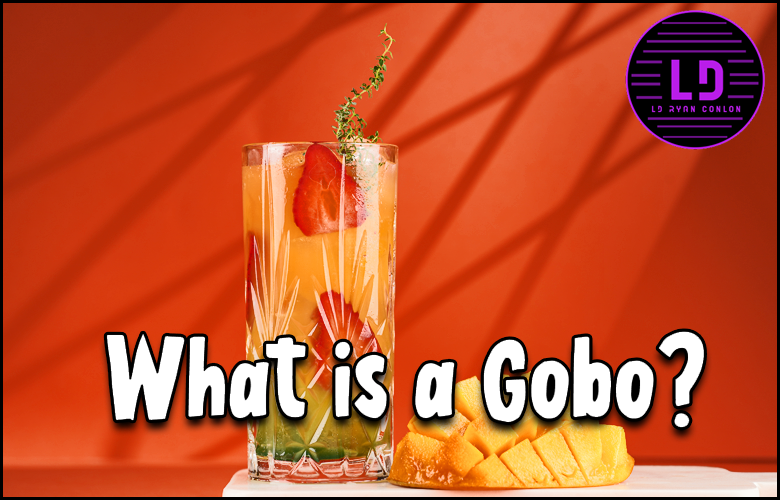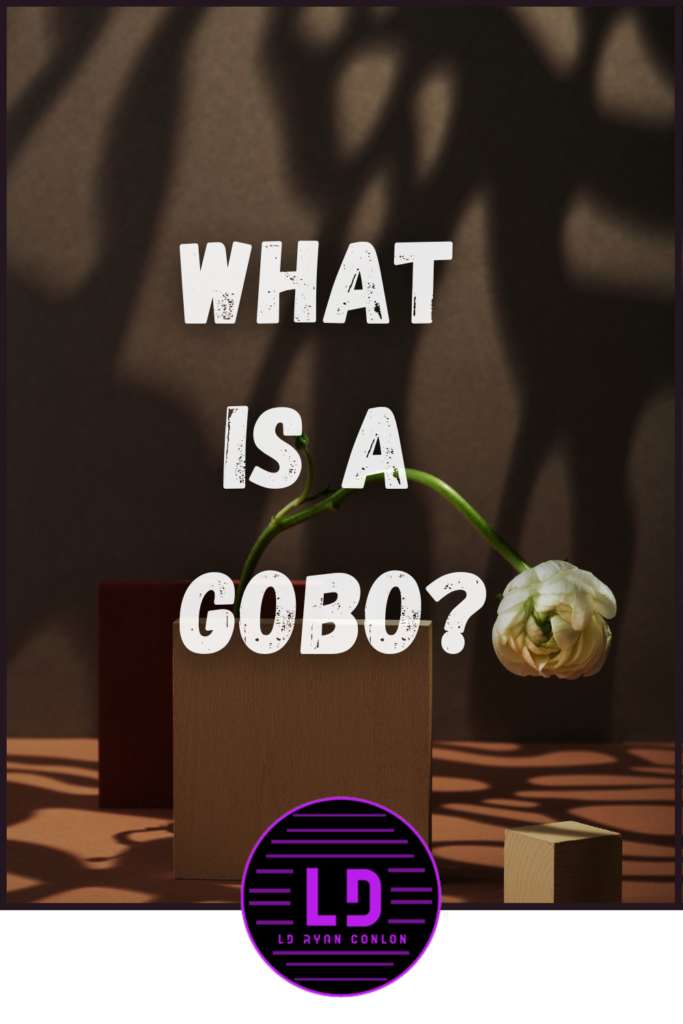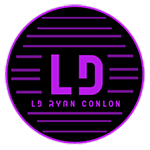
Last Updated on April 21, 2024 by LD Ryan Conlon | 🕒 7 min Read Time
In the breathtaking ballet of Broadway performances, in the flamboyant grandeur of rock concerts, and even in the subdued elegance of our favorite dim-lit eateries, there exists an unsung hero: a Gobo. Imagine holding a kaleidoscope to a light source and watching fascinating patterns dance across your room.
This whimsical effect is just scratching the surface of what a Gobo can do.
From shaping emotions to carving visual experiences, this remarkable tool is revolutionizing how we perceive the world around us.
So fasten your seatbelts as we delve into the fascinating theater of shadows and shapes orchestrated by a relative novice: The Gobo!
What is a Gobo? A gobo is a small stencil or disc made from materials like steel, glass, or plastic that is placed inside or in front of a lighting fixture to control the shape, pattern, or image projected by the light. It allows for the creation of customized visuals such as logos, patterns, or scenery, adding visual interest and enhancing event branding in settings like gala dinners, product launches, and award ceremonies. Gobos are versatile tools widely used in both studio photography and theatrical applications to create specific lighting effects or highlight design elements.
The Origin and Evolution of Gobo
Lighting has always been an essential element in creating the right ambiance, mood, and visual appeal in various settings.
From theatrical productions to corporate events, lighting technicians have employed various techniques and tools over the years to achieve stunning effects.
One such tool that has gained significant popularity in the lighting industry is the gobo.
The term “gobo” originated in cinema studios in the 1930s and may be derived from “go-between” or “go-before.”
Initially, a gobo referred to any opaque panel or flat that was placed between a light source and the subject to control light effects, create shadows, or control reflections.
This technique was widely used in studio photography as it allowed photographers to enhance their compositions and create captivating images.
As technology advanced and lighting equipment became more sophisticated, the concept of a gobo evolved further.
In theatrical applications, gobos started being used with projectors and light sources to create lighting scenes, moving shapes, and architectural lighting effects.
By placing gobos in “the gate” or at the “point of focus,” lighting designers could produce crisp, sharp-edged patterns or designs with precise control over the projected image.
Analogous to how film actors use costumes and makeup to transform themselves into characters on stage or screen, gobos serve as powerful tools for transforming any space into a visually striking setting.
Their ability to project intricate patterns, imagery, and even company logos onto various surfaces gives event planners and designers endless possibilities for creative expression.
To better understand the impact of gobos on creating immersive experiences, let’s consider an example from an award ceremony held at a grand hotel ballroom.
As guests entered the venue, they were greeted by magnificent chandeliers adorned with elaborate glass gobos projecting intricate floral patterns onto the ceiling.
The combination of soft warm hues from the wall wash lights and these gobo projections set the stage for an elegant and enchanting atmosphere, instantly captivating everyone in attendance.
Simply put, gobos have revolutionized the way lighting designers can create visual interest and ambiance in any setting.
Gone are the days when one had to rely solely on static, unchanging lighting setups.
With the use of gobos, lighting technicians can dynamically transform a space from one scene to another, enhancing the overall sensory experience for the audience.
The true power of gobos lies in their ability to convey emotions, tell stories, and reinforce the event theme.
Whether it’s projecting cascading snowflakes during a winter-themed gala or creating a starry night sky effect for a romantic wedding reception, gobos allow event planners to transport guests into a different world altogether.
By manipulating light and shadow, gobos add depth, drama, and intrigue to an otherwise ordinary environment.
Moreover, gobos offer immense flexibility when it comes to customization.
With advancements in technology and manufacturing processes, it is now possible to create highly intricate and detailed glass gobos that accurately reproduce complex images or logos.
This level of customization ensures that every event can have its unique branding elements or visual motifs incorporated seamlessly into the lighting design.
Despite their undeniable impact on creating memorable events, some argue that gobos are merely decorative accessories that don’t significantly contribute to the overall experience.
They contend that traditional lighting techniques can achieve similar effects without the need for specialized equipment like projectors or profile fixtures.
While it’s true that traditional lighting methods have their merits, it’s important to recognize that gobos provide a level of versatility and precision that is unmatched by other techniques.
The ability to project specific designs or patterns onto various surfaces gives lighting designers unparalleled control over the visual narrative being created.
This level of control allows them to tailor the lighting exactly as per the event’s requirements, ensuring every detail is carefully considered.
To illustrate this point, let’s consider the world of painting. Traditional artists use broad strokes and various brushes to create their masterpieces.
While this approach allows them to capture the essence of a scene, it lacks the precision and intricacy that can be achieved by using stencils or highly detailed brushes.
Similarly, gobos act as artistic tools that enable lighting designers to paint with light, adding layers of depth and complexity to the overall visual composition.
- As of 2022, the global gobo market size was valued at around USD 412.3 million and predicted to grow at a CAGR of 5% over the next few years.
- A recent survey in the event planning industry showed that approximately 72% of professional event planners use gobos in their staging designs.
- According to a study in theater arts, gobos are used in nearly 90% of theatrical lighting designs to create visual interest and set ambiance.
Influence on Theatrical Lighting and Stage Productions
Theatrical lighting serves as an essential element in bringing stories to life on stage.
It not only illuminates scenes but also helps convey emotions, enhance performances, and immerse audiences in the world being presented.
Within this realm, gobos have become invaluable tools for lighting designers in creating captivating lighting scenes and sculpting atmospheric environments that transport viewers into different times, places, or moods.
By utilizing projectors or gobo-compatible fixtures, lighting designers can precisely control where light falls on stage and create distinct patterns or images that enhance storytelling elements.
Whether it’s projecting realistic moonlight through trees onto a forested set or casting menacing shadows on a villain’s lair during a suspenseful scene, gobos add depth and texture to the visual narrative.
Consider a production of Shakespeare’s classic tragedy “Macbeth.”
During the iconic “dagger” soliloquy delivered by Macbeth himself, lighting designers may choose to use a gobo projection of a looming dagger to visually represent the character’s internal turmoil and the presence of supernatural forces.
This subtle yet powerful visual cue helps the audience connect more intimately with the character’s psychological journey.
Gobos also play a significant role in creating dynamic and visually captivating stage sets.
By incorporating gobos into scene transitions, lighting designers can quickly transport audiences from one location to another without elaborate set changes.
For example, projecting the silhouette of a cityscape onto a cyclorama instantly transports viewers to an urban setting, while shifting to a swirling vortex effect can whisk them away to a magical realm.
Moreover, gobos enable lighting designers to highlight important elements and draw attention to specific areas on stage.
Whether it’s illuminating a solo performer in a crowded chorus or emphasizing key objects like props or set pieces, gobos help guide the audience’s focus and enhance the overall storytelling experience.
This level of control allows for evocative lighting effects that can elicit emotional responses from viewers and heighten their engagement with the performance.
There are those who argue that excessive use of gobos can distract audiences from the performances themselves.
They claim that elaborate projections or constantly changing lighting scenes may overshadow the actors and dilute the core message of the production.
While it is essential to strike a balance between artistic expression and effective storytelling, it is worth noting that gobos are just one tool within a lighting designer’s arsenal.
Skilled professionals understand the importance of complementing rather than overpowering onstage action with lighting effects.
The judicious use of gobos as part of an overall cohesive design ensures that they contribute harmoniously to enhance the experience rather than detract from it.
Think of gobos in theatrical lighting as scenic elements on stage.
Just as a well-designed set does not overpower or distract from the performances but instead amplifies the story, gobos should seamlessly integrate into the lighting design to enhance the emotional impact of a production.
When used with precision and artistic intent, they become an essential part of the theatrical tapestry, fully supporting the narrative without overshadowing the performances.
Gobo Varieties and Material Considerations
When it comes to gobos, there is a wide variety of options available to choose from.
From different materials to various designs, each gobo has its unique qualities that cater to specific lighting needs and artistic visions.
Let’s take a closer look at the different varieties and material considerations when selecting gobos.
One of the most common types of gobos is the steel gobo.
Steel gobos are known for their durability and affordability, making them a popular choice for many lighting professionals.
These gobos can be easily produced in large quantities, allowing for quick turnaround times when needed for events or productions.
However, steel gobos have their limitations in terms of intricacy and detail due to their manufacturing process.
On the other hand, glass gobos offer a higher level of detail and complexity.
Made from clear glass with a partial mirror coating, these gobos allow for more intricate patterns and designs.
The reflective surface adds depth and dimension to the projected image, creating captivating visual effects.
Glass gobos also have a longer lifespan compared to steel gobos, making them an ideal choice for long-term installations or repetitive use.
Think of steel gobos as the workhorse of the lighting industry, reliable and efficient in delivering simple yet effective lighting effects.
They are like a sturdy utility knife that gets the job done efficiently and cost-effectively.
On the other hand, glass gobos can be likened to a masterpiece created by a skilled artist using delicate brushes and vibrant colors.
They add a touch of sophistication and artistic flair to any lighting design.
Another consideration when selecting a gobo is whether it should be colored or not.
While both steel and glass gobos can be designed with color, glass gobos offer more versatility in this regard.
The color possibilities with glass gobos are virtually limitless, allowing for endless creative options.
In addition to steel and glass, there is a third type of gobo specifically designed for LED fixtures – the plastic gobo.
Plastic gobos provide flexibility and a lightweight construction that is ideal for LED lighting setups.
These gobos can be easily inserted and removed, making them convenient for quick changes during events or performances.
Imagine you are hosting an outdoor event with multiple LED fixtures to illuminate different areas.
You want to project your company logo on walls and surfaces throughout the venue to reinforce your brand identity.
In this scenario, plastic gobos would be the perfect choice. They allow you to easily create custom designs with your logo and insert them into the LED fixtures whenever and wherever needed.
Steel vs. Glass: Understanding Their Unique Qualities
Both steel gobos and glass gobos have their own unique qualities, appealing to different lighting needs and artistic visions.
Let’s dive deeper into the characteristics of each to better understand their strengths and applications.
Steel gobos are fabricated using a metal template from which the image is cut out.
This manufacturing process allows for simple yet effective designs that can deliver striking shadow effects on any surface when projected with light.
These gobos provide clean lines and sharp edges, creating crisp patterns that work well in graphic motifs, logos, or text projections.
Glass gobos, on the other hand, are made from clear glass with a partial mirror coating.
The reflective surface of these gobos enhances the projection by adding depth and dimension.
Glass gobos can produce more intricate designs with delicate details, making them suitable for artistic or decorative scenes.
From floral patterns to abstract shapes, glass gobos lend an air of sophistication and elegance to any lighting installation.
The debate between steel gobos and glass gobos often centers around their cost and applications.
While steel gobos are generally more affordable, they may require modifications or adjustments for optimal display.
On the contrary, glass gobos come at a higher price point but offer superior quality and longevity.
The choice ultimately depends on the specific needs of the project and budget constraints.
Let’s say you are designing lighting for a theater production.
You need to project a scene depicting a starry night sky onto the stage backdrop.
In this case, a steel gobo with a simple pattern of scattered stars would be sufficient to create the desired effect.
On the other hand, if you were designing lighting for an upscale gala event where sophistication and visual impact are paramount, glass gobos featuring intricate lacework or floral designs projected onto walls or ceilings would elevate the ambiance.
Practical Applications of Gobo
Gobos may seem like a small component in the world of lighting effects, but they have an immense impact on various practical applications.
From corporate events to theatrical productions, gobos play a crucial role in enhancing visual experiences and creating memorable environments.
One practical application of gobos lies in the realm of architectural lighting.
Imagine walking down a bustling city street at night, and suddenly your attention is drawn to a building bathed in vibrant colors with intricate patterns projected onto its façade.
This captivating display is made possible by the creative use of gobos.
By projecting specific patterns or images onto buildings, architects and designers can transform the entire feel of a space, turning it into a work of art that interacts with its surroundings.
For instance, I recently attended a fundraising event held at a historic theater.
As I entered the auditorium, my eyes were immediately drawn to the mesmerizing ceiling illuminated with a stunning gobo projection of constellations.
The ethereal effect transported me to an otherworldly atmosphere, perfectly complementing the event’s celestial theme.
Another practical application of gobos can be found in concert production and live performances.
When you attend a concert or music festival, you’re not only there for the music; you also crave an immersive experience that engages your senses.
Lighting design plays a pivotal role in creating these immersive environments, and gobos are often used to add depth and visual interest to the stage.
Think about it this way: just as musicians use different instruments to create layers and textures within their music, lighting designers use gobos to create layers and textures within the visual landscape of a performance.
A well-placed gobo can transform an ordinary stage into an awe-inspiring spectacle, transporting audiences into the artist’s world.
One powerful example of gobo usage in live performances is the iconic silhouette technique employed by many artists.
By projecting a performer’s silhouette onto a screen, a sense of mystery and anticipation is created, leaving the audience captivated as they eagerly await the moment when the artist steps into the light and reveals themselves.
In addition to their use in architectural lighting and live performances, gobos are also valuable tools in the world of photography.
Photographers often employ gobos to control light and create unique visual effects in their images.
Whether it’s using a gobo to create dramatic shadows or shaping light to highlight specific elements, gobos give photographers the creative freedom to manipulate light and shape their compositions.
As an avid photographer myself, I have experimented with gobos during portrait sessions.
By placing a gobo between my subject and the light source, I was able to precisely control the direction and intensity of the light, resulting in stunning contrast and depth in my images.
Gobos allowed me to add that extra touch of creativity, making my photographs stand out from the crowd.
Some may argue that with advancements in digital technology and post-processing techniques, the need for physical gobos in photography is diminishing.
While it’s true that digital manipulations can achieve similar effects, there’s something inherently tangible and authentic about working with physical gobos.
They offer a hands-on approach that allows photographers to experiment in real-time and make creative decisions on the spot.
As we’ve explored these practical applications of gobos, it becomes clear that their versatility knows no bounds.
From transforming architectural spaces to enhancing live performances and adding creativity to photography, gobos have become indispensable tools for professionals across various industries.
Enhancing Event Aesthetics and Branding
One area where gobos excel is in event aesthetics and branding. In today’s modern world, creating a memorable event experience goes beyond just selecting a venue or planning an agenda.
It involves thoughtful attention to detail, including visual elements that resonate with attendees and leave a lasting impression.
When it comes to corporate events such as gala dinners, product launches, or award ceremonies, event branding is a crucial aspect.
Companies invest significant resources in building and maintaining their brand identities, and incorporating gobos into event lighting can be an effective way to reinforce brand recognition and create a cohesive atmosphere.
Picture this: you’re attending a high-profile product launch for a luxury fashion brand.
As you walk into the venue, you’re greeted by a grand entrance adorned with elegant projections of the brand’s logo in a captivating display of light.
The seamless integration of the gobo projections not only creates a visual spectacle but also reinforces the connection between the company and its products, leaving a lasting impression on all who attend.
Whether it’s projecting logos onto walls, floors, or customizing gobos to highlight specific elements of an event design, gobos offer endless possibilities for enhancing event aesthetics.
They serve as visually striking alternatives to traditional banners and signage while providing something unique and visually different for the audience.
Furthermore, gobos are particularly effective when it comes to creating patterns, imagery, and shapes that align with the event theme.
Let’s say you’re organizing a charity fundraiser with an underwater theme.
By utilizing gobos featuring ocean-inspired patterns such as waves or coral reefs, you can instantly transport attendees into an immersive underwater world.
The convergence of lighting effects and thematic elements creates an unforgettable experience that amplifies the overall impact of the event.
While gobos undoubtedly have the power to enhance event aesthetics and branding, some may argue that they are an additional expense that may not always be necessary.
After all, there are other cost-effective ways to create visually appealing events without the need for intricate lighting effects.
However, it’s important to recognize that in today’s highly competitive event landscape, standing out from the crowd is crucial.
By using gobos strategically, organizers can create a sense of exclusivity, professionalism, and attention to detail that sets their event apart.
Gobos offer a way to elevate the overall aesthetic of an event, leaving attendees with a sense of awe and appreciation for the effort put into creating a visually stunning experience.
The practical applications of gobos in event aesthetics and branding are undeniable.
From projecting logos and patterns to immersing attendees in thematic environments, gobos provide a powerful tool for event professionals to unleash their creativity and transform ordinary spaces into extraordinary experiences.
Advanced Uses and Innovative Practices with Gobo
Gobos have come a long way since their inception, evolving from simple static images projected onto surfaces.
Today, they are used in a variety of advanced and innovative ways, adding depth and creativity to lighting effects.
In this section, we will explore some of the exciting applications where gobos are pushing the boundaries of light projection.
One remarkable use of gobos can be seen in architectural lighting.
Imagine walking down a city street at night and being greeted by an awe-inspiring light display projected onto the façade of a building.
With the use of dynamic gobos, architects and lighting designers can transform ordinary structures into captivating works of art.
These dynamic gobos can create moving patterns, swirling colors, or even simulate natural phenomena such as raindrops or falling leaves.
This technology has revolutionized urban environments, turning them into mesmerizing visual experiences.
Another advancement in gobo technology is the incorporation of video projection mapping.
By combining carefully crafted gobos with precise mapping software, artists and designers can project intricate animations onto complex surfaces, such as sculptures or entire buildings.
This technique has been utilized in large-scale events like music festivals and art installations to create immersive environments that blur the line between reality and digital art.
Some may argue that these advanced uses of gobos take away from the purity of traditional lighting design.
They might claim that too many moving patterns and projections can distract from the overall aesthetics or intended message of an event or space.
While there is merit to this argument, it ultimately comes down to the skill and creativity of the lighting designer.
By using gobos thoughtfully and purposefully, these advanced techniques can enhance the overall experience without overshadowing the intended design.
Think of it this way: Just as an artist uses different brushes and pigments to create a masterpiece, a lighting designer uses gobos as their tool to paint with light.
And just like any other art form, it is up to the artist to wield their tools responsibly and create something that is visually stunning and emotionally impactful.
In the realm of live performances, gobos have also found a place in enhancing the storytelling aspect of theatrical productions.
By using gobos in combination with moving fixtures or lasers, lighting designers can create dynamic scenes that transport the audience into different worlds.
For example, a gobo combined with smoke effects can mimic the ethereal glow of a moonlit forest or the flickering flames of a raging fire.
These immersive experiences bring scripts to life and have the power to evoke powerful emotions in the audience.
The versatility of gobos extends beyond just environmental projection.
They are also being used in more focused applications, such as highlighting specific objects or products in retail spaces.
By strategically placing a gobo projector, retailers can draw attention to key areas or merchandise displays, creating visual focal points that guide customers throughout the store.
This not only enhances the shopping experience but also helps boost sales by showcasing products in an interesting and engaging way.
As technology continues to advance, so too does the potential for innovative uses of gobos.
From architectural lighting to theatrical performances and retail displays, the possibilities are endless.
The key lies in balancing creativity and intentionality to create truly remarkable lighting effects that captivate audiences and elevate spaces to new heights.
The next time you encounter a captivating light display or find yourself immersed in an imaginative environment, take a moment to appreciate the role that gobos play in bringing these visions to life.
Related Posts
- What is a Ghost Light? The Truth About This Theater Tool
- Role of a Stage Lighting Technician
- The Ultimate Guide to Getting Started in Stage Lighting Design
- What is a Rigger? A Guide to Working in the Industry
Pins for Pinterest
If you like what you see, feel free to share some love on Pinterest ❤️


Ryan Conlon is a highly experienced Corporate Freelance Lighting Designer with two decades of dedicated work in the entertainment industry. With a passion for creating captivating lighting experiences, Ryan has contributed his expertise to numerous corporate meetings, stage productions, concerts, and events throughout his career.
